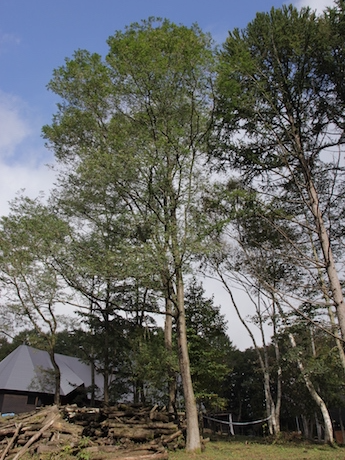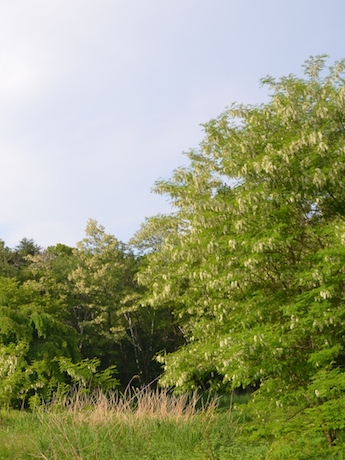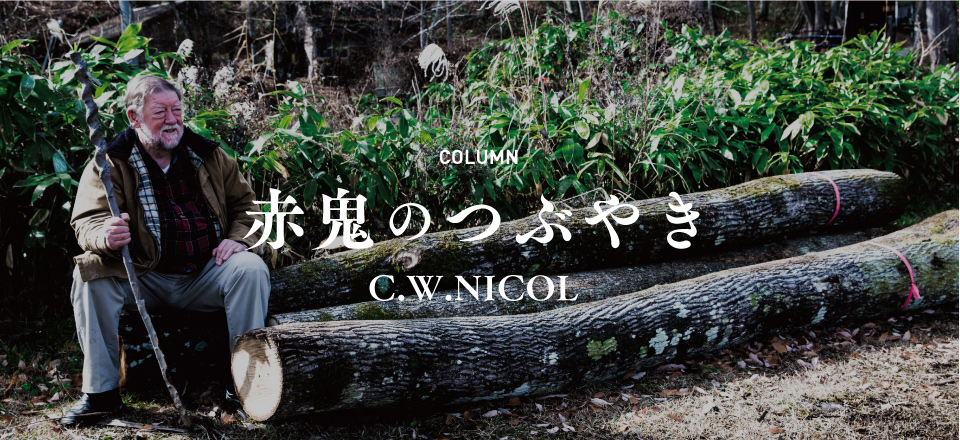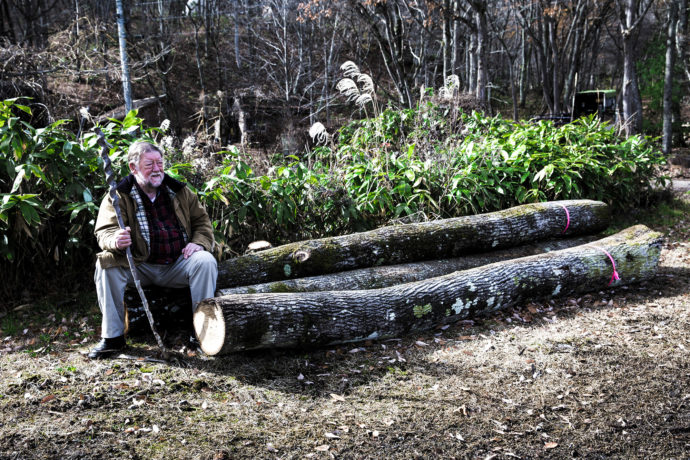Column
【赤鬼のつぶやき C.W.ニコル】ニセアカシア(False Acacia)

ミツバチを飼い始めた30年ほど前に、湿地にある土地の一画を購入しました。排水のために溝をつくり、池を掘って、クリやトチ、サクラと一緒にニセアカシアを植えました。北米産のこの木は、アメリカで「black locust」と呼ばれています。造林の目的や、海岸などでの侵食防止、そして蜂蜜を集めるために、日本へ持ち込まれたのは1873年のことでした。いまでは外来植物として知られていて、この木は種子でも、吸収根という根によっても広がります。
アファン財団がホースロッジを建てたのもこの場所です。ホースロッジで使う家具は、馬搬で曳き出した広葉樹の木材を使って、岡村製作所にデザインと製作をお願いしました。学生向けのワークショップも開催していただきました。ここのニセアカシアはできるだけ伐りました。ホースロッジの室内にはアメリカ製の薪ストーブがありますが、ここには2、3年分の薪がまかなえるほどのニセアカシアが切りそろえて積んであります。


ニセアカシアの材は世界中で高く評価されています。花の蜜の価値はさておいても、淡いイエローブラウンの材木は、硬質で高密、腐りにくく、家具や床の材料や、柵や小さなボートにも使われているのです。枯れてしまったものや、よく乾燥させた木は、高級な薪にもなります。
とても良い香りがするきれいな花が咲くと、オレンジの花のような匂いがします。花からはたくさんの蜜がとれます。雌雄同体の花はやがて豆のような鞘をつけ、枝にぶら下がったままで冬を越し、早春になると弾けます。ニセアカシアの繁殖力はとても強く、マメ科の植物の根っこにできる根粒と呼ばれる瘤が、土の中の窒素を固定して成長が促進されます。花は天ぷらにするとおいしく食べられますが、葉などには毒があり、ウマが中毒症状を起こす原因にもなります。これからはニセアカシアが生えたら刈り取っていかなくてはならないでしょう。
ホースロッジの敷地には、まだ数本のニセアカシアの木が残っているので、駆除する予定です。クリやトチノキ、サクラの木は、ウマたちがひとやすみする木陰を提供するほどに順調に育っています。どの木にも素敵な花が咲き、花の蜜はミツバチたちが集めてくれ、その恩恵を授かることができます。もちろん美味しいクリの実は、近所に棲んでいる野生のイノシシたちに狙われています。そして、薪割りをしないといけないニセアカシアの丸太の束が、まだ山のように残っています! 誰か手伝ってもらえないでしょうか?
2017年8月
C.W. ニコル
写真提供:C.W.ニコル・アファンの森財団
FALSE ACACIA (Nissei acacia – Robinia pseudoacacia)

About thirty years ago, when I started keeping honey bees, I bought a plot of rather soggy land, laid in drainage pipes, dug a pond and planted chestnut, horse chestnut, cherry, and false acacia. False acacia is native to America, where it is called ‘black locust’ and was brought to Japan in 1873. This tree has spread all over Japan, and has been used for afforestation, erosion control and for the production of honey. In many areas false acacia is now considered invasive. It certainly spreads, either through seeds or root suckers.
We built our horse lodge on this land. Okamura Company designed and produced hardwood furniture for the horse lodge from timber extracted by of horses, also holding workshops for students. We trimmed out almost all of the false acacia trees. We have a fine American wood stove in the lodge, and as I write, we have about two or three years supply of false acacia logs that need to be cut, split and stacked for firewood.
False acacia wood is greatly prized in many countries. Apart from being a valuable honey producer, the pale yellow-brown timber is hard, dense and rot resistant, and is used for making furniture, flooring, fence posts and even small boats. Once seasoned and dried it makes excellent firewood.
The tree produces beautiful, fragrant clusters of flowers that smell a bit like orange blossom and produce lots of nectar. Each flower has both male and female parts, and they grow into pea-like pods that mature in autumn and stay on the tree until they pop open in early spring. The tree spreads vigorously. Being leguminous, the roots of this tree have a small nodule that fix nitrogen and enriches the soil in which it grows. Unfortunately, although the flowers make tasty tempura, the leaves are toxic to horses, so we will have to keep on cutting them as they grow.
On our horse lodge land we still have a few false acacia trees, but they will be controlled. The chestnut, horse chestnut and cherry trees are growing well and make good shade trees for the horses. We appreciate the blossoms, and bees love the nectar. The chestnuts are delicious, as our local wild boars have discovered. But oh boy, we have an awful lot of firewood to split! Any volunteers?
C.W.Nicol
August 2017
C.W.ニコル
作家・1940年イギリス南ウェールズ生まれ。1995年日本国籍取得。カナダ水産調査局北極生物研究所の技官・環境局の環境問題緊急対策官やエチオピアのシミエン山岳国立公園の公園長など世界各地で環境保護活動を行い、1980年から長野県在住。1984年から荒れ果てた里山を購入し「アファンの森」と名づけ、森の再生活動を始める。2005年、その活動が認められエリザベス女王から名誉大英勲章を賜る。2011年、2016年に天皇、皇后両陛下がアファンの森をご視察された。





